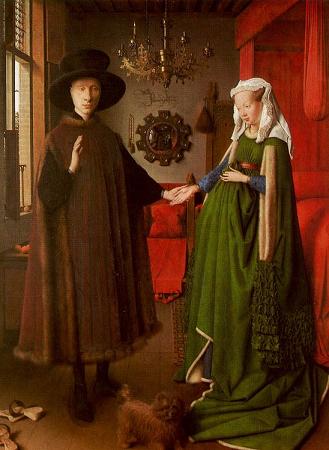Virgin and Child in Church (c1438). Oil on panel. 32 x 14. Madonna in the Church is a small oil panel by the early Netherlandish painter Jan van Eyck. Probably executed between c. 1438-40, it depicts the Virgin Mary holding the Child Jesus in a Gothic cathedral. Mary is presented as Queen of Heaven wearing a jewel-studded crown, cradling a playful child Christ who gazes at her and grips the neckline of her red dress in a manner that recalls the 13th-century Byzantine tradition of the Eleusa icon. Tracery in the arch at the rear of the nave contains wooden carvings depicting episodes from Mary's life, while a faux bois sculpture in a niche shows her holding the child in a similar pose. Erwin Panofsky sees the painting composed as if the main figures in the panel are intended to be the sculptures come to life. In a doorway to the right, two angels sing psalms from a hymn book. Like other Byzantine depictions of the Madonna, van Eyck depicts a monumental Mary, unrealistically large compared to her surroundings. The panel contains closely observed beams of light flooding through the cathedral's windows. It illuminates the interior before culminating in two pools on the floor. The light has symbolic significance, alluding simultaneously to Mary's virginal purity and God's ethereal presence. Most art historians see the panel as the left wing of a dismantled diptych; presumably its opposite wing was a votive portrait. Near-contemporary copies by the Master of 1499 and Jan Gossaert pair it with two very different right-hand images: one is of a donor kneeling in an interior setting; the other is set outdoors, with the donor being presented by St Anthony. Both painters made significant alterations to van Eyck's composition, which may have brought the image more up to date with contemporary styles, but the copies have been described as spiritually if not aesthetically disastrous to the original concept. Madonna in the Church was first documented in 1851. Since then its dating and attribution have been widely debated amongst scholars. At first thought an early work by Jan van Eyck, and for a period attributed to his brother Hubert van Eyck, it is now definitively attributed to Jan and believed to be a later work, demonstrating techniques present in work from the mid-1430s and later. The panel was acquired for the Berlin Gemeldegalerie in 1874. It was stolen in 1877 and soon returned, but without its original inscribed frame, which was never recovered. Today Madonna in the Church is widely considered one of van Eyck's finest; Millard Meiss wrote that its splendor and subtlety of of light is unsurpassed in Western art. The attribution of the panel reflects the progression and trends of 19th and 20th-century scholarship on Early Netherlandish art. It is now thought to have been completed c. 1438-40, but there are still arguments for dates as early as 1424-29. As with the pages ascribed to Hand G in the Turin-Milan Hours manuscript, the panel was attributed to Jan's brother Hubert van Eyck in the 1875 Gemeldegalerie catalogue, and by a 1911 claim by art historian Georges Hulin de Loo. This is no longer considered credible and Hubert, today, is credited with very few works. By 1912 the painting had been definitively attributed to Jan in the museum catalogue. Attempts to date it have undergone similar shifts of opinion. In the 19th century the panel was believed to be an early work by Jan completed as early as c. 1410, although this view changed as scholarship progressed. In the early 20th century, Ludwig von Baldass placed it around 1424-29, then for a long period it was seen as originating from the early 1430s. Erwin Panofsky provided the first detailed treatise on the work and placed it around 1432-34. However, following research from Meyer Schapiro, he revised his opinion to the late 1430s in the 1953 edition of his Early Netherlandish Painting. A 1970s comparative study of van Eyck's 1437 Saint Barbara concluded that Madonna in the Church was completed after c. 1437. In the 1990s, Otto Pacht judged the work as probably a late van Eyck, given the similar treatment of an interior in the 1434 Arnolfini Portrait. In the early 21st century, Jeffrey Chipps Smith and John Oliver Hand placed it between 1426 and 1428, claiming it as perhaps the earliest extant signed work confirmed as by Jan. At 31 cm x 14 cm, the painting's dimensions are small enough to be almost considered miniature, consistent with most 15th-century devotional diptychs. A reduced size increased portability and affordability, and encouraged the viewer to approach the piece to more closely see its intricate details.
more...






